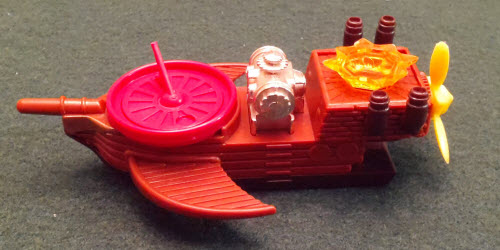So, hypothetical question: if you and three other people were stranded in an ancient city in the desert, and your only hope of survival before the landscape did you in was to explore said city, uncover lost treasures, assemble a skyship, and make your way back out again, who would you take?
Would you go an all-star fictional route, with the likes of Philleas Fogg, Indiana Jones, and Rick O’Connell? Or how about Allan Quartermain, Laura Croft, and MacGyver? Alternatively, you could choose take some real life adventurers, such as Meriwether Lewis, Gertrude Bell, and Zheng He. Or perhaps you’d prefer David Livingstone, Francis Drake, and Louise Boyd.
There’s quite a few choices, so make them well. Because your helicopter is going down…now.
The Premise
Players are an adventure-seeking expedition group who have been sent into the desert to find and uncover a legendary sun-powered airship that has been lost to the ages. However, their helicopter has crashed, they’re low on supplies, and a massive sandstorm approaches. They must now reassemble the airship and escape before the desert swallows them whole.
The Rules
Forbidden Desert is a tile-based Co-Op game with little setup required. To start, the tiles are set up in a 5×5 square grid with an opening in the middle (being the Sandstorm). Next, Sand markers are placed on eight tiles in a diamond pattern, forming the starting board. Each player is also randomly dealt an Adventurer role card. These role cards provide special abilities that are used throughout the game. They are also used to keep track of current water rations. Once roles have been assigned, each player’s pawn is placed on the starting tile depicting the crash site.
The game also comes with two decks of cards: the Equipment deck and the Storm deck. Equipment cards are special single-use items that can be attained while exploring for the airship, and the cards detail their uses. They provide a number of powerful tools that can be saved and used until the time is right. Conversely, the Storm deck determines the negative effects of the environment each turn.
Each player’s turn consists of two steps, with the thirstiest player starting. First, the player takes their choice of up to four actions, being Move, Remove Sand, Excavate, or Pick up a Part, and they may take them in any order and amount they wish.
Move allows the player to move one space orthogonally adjacent to them.
Remove Sand clears one Sand marker on or adjacent to their location. This is important, as tiles may not be Excavated and located airship pieces can not be gained via the Pick up a Part action so long as the tile has Sand on it. Tiles with two or more Sand markers are considered impassible.
Lastly, with Excavate the player flips the desert tile over to reveal what is buried beneath. Revealed tiles depict a number of possible results; the most common depicts a Gear symbol. When a Gear is revealed, the active player gains the top Equipment card. Others tiles include water wells that provide one-time water rations, or a set of tunnels that permit movement between them. The most important tiles, however are the Location tiles. They are needed to reveal where the four airship pieces are to be found. Each airship piece has two corresponding tiles that specify which row or column that piece is in. When both Locations for a piece are revealed, the piece is placed at the intersecting location on the grid.
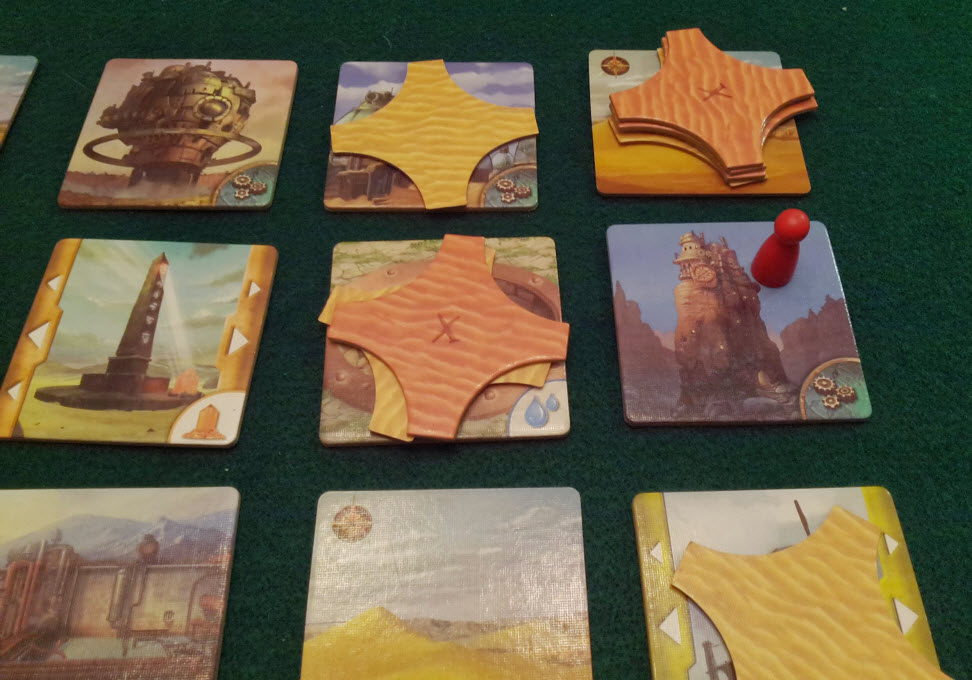
Red would like to get at the corner tile since they’re sure it’s a Location tile, but it’ll take several actions to clear it all off.
Once the player takes their final action, they then reveal and resolve the Storm deck, with the number of cards revealed equal to the current Storm meter level. Storm cards have three possible outcomes. First are the movement cards. Heavy desert winds cause the tiles near the Sandstorm to shift. The direction and number of tiles that move are shown on the card. Whenever a tile shifts, a Sand marker is placed on it. Should there not be enough Sand markers available to place, the players are deemed buried in the desert and lose.
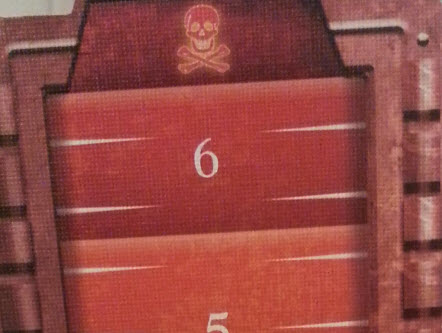
Skull & Crossbones. Subtle.
Second are the Sun Beats Down cards, which cause players to lose one water on their role card. If a player runs out of water, they die of thirst and everyone loses. Finally are the Storm Picks Up cards, which cause the Storm level to rise. If this causes the Storm level to reach past six, the players are lost to the storm…and everyone loses.
If, however, all players are alive and accounted for afterwards, it becomes the next player’s turn.
The game continues until either the players acquire all four airship pieces and everyone makes it to the Launch Pad tile to escape, or until they lose to the merciless, unforgiving desert conditions.
The Winds of Change
Forbidden Desert is, in many ways, a direct sequel to the popular Gateway Game Forbidden Island. Designed by the same person (Matt Leacock) and released by the same publisher, many familiar interactions and mechanics are present in some form, such as the co-op nature, specialized player roles, and an ever-dwindling timetable to win. That said, rather than being a mere reskin, set in some steampunk-themed desert ruins, the intent was to create the next test for those who felt they had a firm grasp on Forbidden Island. Apparently, getting off a sinking island is easier than getting out of a howling sandstorm.
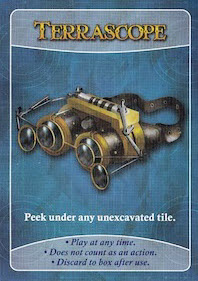
Journal Entry: if we make it out, patent Terrascope.
Indeed, Forbidden Island made a big impact as a gateway game enjoyable both for the hobby gamer and the family game night. It presented just enough decision-making to allow players a direct impact on their survival while still leading much of the outcome to random chance. In Forbidden Desert, the model is similar. To win, players must work as a team by discussing strategy, sharing resources, and ultimately, hoping that luck is on their side.
Comparatively though, there is a small but discernible uptick in complexity over its predecessor: the utility-based Equipment cards have a wider variety of uses, the land tiles serve more than one function, and there are multiple areas to focus on. Water, Sand markers, and time are all a constant concern, often leading players to make difficult choices. With more moving pieces – literally – and more areas needing attention in order to stave off defeat, Forbidden Desert presents new challenges in a familiar package.
Not Military-Grade Equipment
The moving pieces do come with a small caveat. While still providing a visually appealing layout, some of the pieces don’t hold up as well to its harsh desert conditions. The attachable clips for the Adventure cards, the ones used for water tracking, are little rigid, and they have a tendency to ding the cards. The clips themselves are also capable of breaking. If you notice this happening, we recommend either putting the Adventure cards in hard-backed sleeves, or using some other method to track your water levels such as six-sided dice or beads.
What’s more, a word of caution regarding the airship itself. Overall, it’s a fantastic thematic addition to the game without possessing a big functional use, and the quality of the fuselage and engine specifically are impressive.
The propeller…not so much. It’s a good fit on the nose of the ship – but it’s possible to break getting it back off again. It may be wise to skip adding that piece directly every time since it’s purely for show.
The Shifting Fortunes of Arrakis
Forbidden Desert is transition away from a pure Gateway game, but not so far as to be with put with games of advanced skillset requirements, complex mechanics, or lengthy time commitments. We call this second stage a Gateway Plus Game. Even so, it doesn’t stray much from its roots with the same degree of player interaction and easy to learn rules, which keeps the game Socializer friendly.
On the other hand, Tacticians are of a split mind. Forbidden Desert involves having to be very fluid with your strategy every turn, constantly making adjustments on the fly, and this appeals to their tinkering nature. However, it is not a game that is capable of a grand design, with players rarely thinking more than a turn ahead, and this stymies their planning side. There’s enough strategy to appease them for awhile, but whether a Tactician will enjoy the game over many sessions will depend on the individual player.
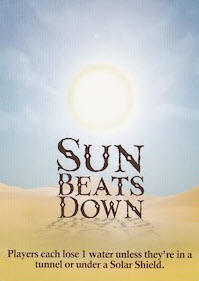
No amount of skill, though, can completely diminish the amount that random luck plays in the game. Is that water well actually a mirage? Is the Location card hopelessly buried and inaccessible? Did back-to-back Sun Beats Down cards just happen…again?
Any and all of those are possible, even in the same playthrough. This style of luck is more a chaotic ‘luck of the draw’ kind than an equalizing force, and that has an impact on the archetypes.
Strikers, for example, would potentially enjoy the challenge of beating the system, but the amount of unpredictability will ultimately frustrate most of them. Surprisingly, the same can be said of Daredevils here. Sure, there is a lot of randomness happening, but it’s the game causing it, not their actions. Moreover, since it’s a co-op game of winning as a group, that puts them on a fairly short leash for gambles, and they won’t enjoy that in the long term.

So, who’s thirsty?
On the flip side, the chaotic luck may be a positive for Immersionists who embrace the idea of being trapped in a swirling desert storm that causes the landscape to shift. It’s not a world-building exercise per se, but they’ll appreciate that it has a soundly resonant theme for a fairly light game.
Still, like similarly styled games, Forbidden Desert is a co-op game about exploration and survival, with the emphasis on the latter. As a result, Architects will likely be mixed as well. Flipping tiles to uncover the lost city and collecting the airship pieces will indeed be appealing flavor wise, but there are no individual resources to hoard. Still, it could be enough to appeal to their Civ-building nature.
The Takeaway
Forbidden Desert starts off with the players in survival mode from turn one and never slows down. On the one hand, it makes the game fairly short, and there is always a level of engagement with everyone involved. On the other hand, it creates situations that are continually precarious and tense; you never know when the other shoe is going to drop. Its rules are marginally more complex than Forbidden Island, but the game is still incredibly accessible to newer players because it manages to up the complexity without weakening its accessibility to a wider audience.
Forbidden Desert makes for a fantastic Gateway Plus game, aimed at those who feel they have mastered the land of Forbidden Island – or those who felt the latter was too simple to begin with. Essentially, if you liked the Island, you’ll like the Desert, and if you didn’t like the Island, there’s at least a chance you’ll find something you felt was lacking here. It’s a challenging, team-oriented race against time, and there’s no guarantee of making it out. That’s part of the fun. Forbidden Desert certainly feels like an adventure from another age. If lost airships and impending disaster sound intriguing to you, then grab your shovel and dig on in.
Forbidden Desert is a product of Gamewright Games.
Cardboard Republic Snapshot Scoring (Based on scale of 5):
Artwork: 4
Rules Clarity: 5
Replay Value: 5
Physical Quality: 4
Overall Score: 4.5
Photo Credits: Cup of water by Stockphotosforfree.

